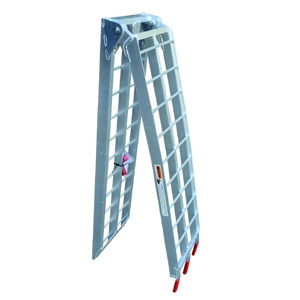Understanding Motorcycle Ramp Angles and Their Importance
The Physics Behind Ramp Angles
Motorcycle ramp angles play a pivotal role in the loading process. The angle of incline directly affects the amount of force required to move your motorcycle up the ramp. Wheel spin or unsteadiness could result from the increased effort and control required at a steeper angle. Conversely, a shallower angle reduces the effort needed but requires a longer ramp.
Safety Considerations
Safety should be your primary concern when selecting a motorcycle ramp angle. An overly steep incline increases the risk of the motorcycle tipping backwards or losing traction. If this were to happen, you run the danger of injuring yourself or wrecking your prized vehicle. A gentle slope allows for better control and reduces the likelihood of accidents during loading and unloading.
Efficiency in Loading and Unloading
Loading is facilitated more easily and efficiently with the correct ramp angle. It speeds up the process and eases the strain on the bike and the rider, making the work easier. An optimal angle allows for easy acceleration up the ramp without excessive throttle input, reducing wear on your clutch and transmission.
Factors Influencing the Ideal Motorcycle Ramp Angle
Motorcycle Weight and Power
When selecting the right ramp angle, your motorcycle’s weight and engine power are critical factors. Heavier bikes are harder to push or ride up steep ramps, increasing the risk of tipping or losing control. While more powerful motorcycles might manage steeper inclines more effectively, it’s still important to prioritize safety. Balancing the weight-to-power ratio helps determine a safe, manageable angle that prevents overexertion or strain during loading, especially when working alone or in tight loading environments.
Ground Clearance and Wheelbase
Motorcycles with low ground clearance are at higher risk of scraping or bottoming out on steeper motorcycle ramps. A longer wheelbase can reduce the angle at which the bike can safely approach the ramp without contacting the ground. These factors combined mean that bikes like cruisers or touring models often require shallower ramps for safe loading. A gradual incline helps protect the frame, exhaust pipes, and other underbody components from potential damage, especially when loading onto higher platforms like trucks or trailers.
Loading Surface and Environmental Conditions
The type of loading surface and external conditions can affect the safety and usability of a motorcycle ramp. If the surface is slick, uneven, or wet, a shallower angle improves traction and minimizes the chance of slipping. Windy or unstable weather also makes steep inclines risky, particularly when trying to maintain balance. Evaluate your surroundings before loading, and adjust your ramp angle accordingly to enhance safety. Portable ramps with adjustable lengths can be particularly useful in adapting to varying environmental and surface conditions.
Practical Tips for Choosing and Using Motorcycle Ramps
Measuring and Calculating Ramp Angle
Before using a motorcycle ramp, it's important to determine the correct ramp angle for safe loading and unloading. Begin by measuring the vertical height from the ground to the loading surface, such as a truck bed or trailer. Then, measure the full length of the ramp. Using these two measurements, calculate the angle either with basic trigonometric formulas or an online ramp angle calculator. To decrease danger, provide better control, and protect yourself and your motorbike from accidents, keep the ramp angle within the recommended range of eleven to fifteen degrees.
Ramp Material and Construction
The ramp’s material plays a vital role in its performance and safety. Aluminum is a top choice because it’s strong yet lightweight, making it easy to transport and durable under heavy loads. Ensure the ramp you select can handle your motorcycle’s weight and is constructed with quality welding and reinforcements. Side rails, serrated steps, and anti-slip surfaces all work together to make the stairs safer and more secure to use. Having a sturdy ramp installed not only makes loading much easier, but it also greatly decreases the likelihood of accidents like slips, falls, or broken equipment.
Proper Ramp Setup and Usage
Setting up your ramp correctly is essential for safe operation. Always anchor the ramp securely to the loading platform using strong straps, hooks, or safety chains to prevent shifting. Align the ramp so it is centered and straight, and confirm that both ends are firmly supported. When riding up or down, maintain a smooth and consistent speed without abrupt throttle changes or braking. Wearing proper gear and having a spotter guide you from the side adds another level of safety. To make sure everything goes well and safely during loading, be sure to be prepared and careful.
Conclusion
A crucial component of safe and effective loading is choosing the correct motorcycle ramp angle. While the ideal range of 11-15 degrees serves as a useful guideline, it's essential to consider your specific motorcycle and loading conditions. Guaranteed safe loading every time is possible with an awareness of the variables that affect ramp angles and the application of correct setup and usage procedures. Remember, when in doubt, opt for a longer ramp with a gentler incline to prioritize safety and protect your valuable motorcycle.
Contact Us
For more information about our high-quality motorcycle ramps and other motorcycle maintenance tools, please don't hesitate to contact us at info@runva.com.cn. Our team of experts is ready to help you find the perfect solution for your motorcycle loading needs.

_1737625693698.webp)


